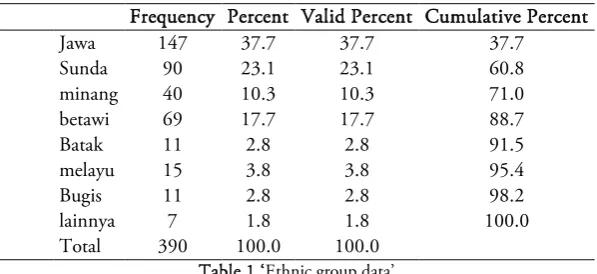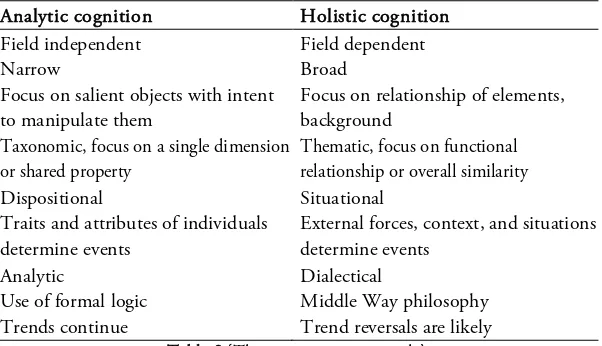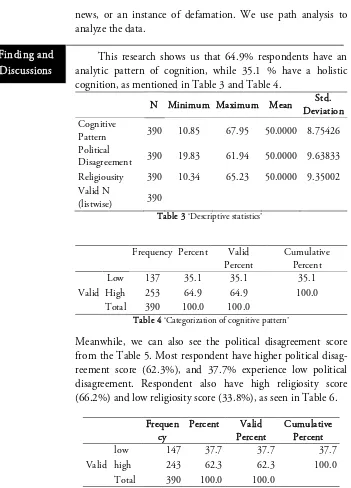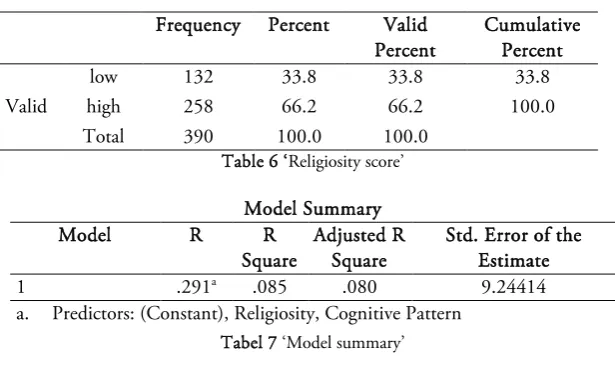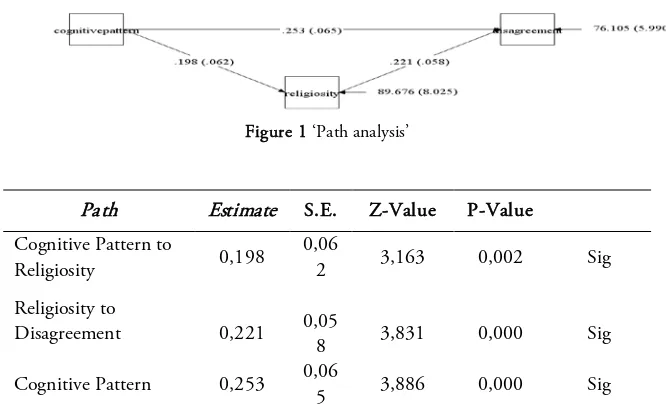on Social Media During Political Disagreements
Rena Latifa
1, - [email protected]
Abdul Rahman Shaleh
2, - [email protected]
Melanie Nyhof
3- [email protected]
Abstract: The 2017 Jakarta governor election had encoura-ged polarization among Muslims, including among media social users: those who agreed and those who disagreed with voting for Basuki Ahok Tjahaja Purnama since he was prosecuted for allegedly committing blasphemy. This study has examined the cognitive pattern amongst disputants: whether cognitive pattern and religiosity contribute to poli-tical disagreements or not. Participants were Indonesia’s Muslim social media users (N = 300). U sing multiple regres-sion analysis, the findings have demonstrated that analytical thinking produces higher disagreement than holistic thinking. In addition, higher level of religiosity produces higher disagreement.
Keywords: Indonesian Muslim, political disagreements, cognitive pattern, social media
Abstrak: Pemilihan gubernur D KI Jakarta 2017 memantik polarisasi di kalangan umat muslim, termasuk di kalangan muslim pengguna media sosial. Ada yang setuju dan ada yang tidak setuju untuk memilih Basuki Ahok Tjahaja Pur-nama sebagai gubernur. Studi ini membahas apakah pola kognitif dan religiusitas berkontribusi pada ketidaksepema-haman politik; pola kognitif seperti apa (analitis atau holistik) yang paling banyak diikuti umat Islam? Responden penelitian adalah umat Islam pengguna media sosial (N = 300). Melalui analisis regresi berganda, studi ini menemu-kan bahwa pola kognitif-analitis mendorong terjadinya
political disagreement lebih tinggi daripada pola kognitif-holistik. Selain itu, semakin tinggi tingkat religiusitas sese-orang, maka semakin tinggi pula kemungkinan political dis-agreement itu terjadi.
Introduction
In the realm of political behavior, a recent revival of interest in disagreement stems from normative theories of political deliberation that promote a different view of how representative democracy funct-ions effectively. Though liberal democratic theories emphasize the need for individuals to be civically engaged in order to be politically active, deliberative theories focus on collective processes and the exchange of viewpoints. While theoretical discussion of deliberative democracy is lively and well developed, empirical scholarship on the mass public has focused principally on the question of the behavioral impact of political disagreement (Klofstad, Sokhey, & McClurg, 2012, p.1).
Indonesia is a genuine democracy incorporating open society, re-ligious, and ethnic pluralism. Its national motto even translates as ‘Unity in Diversity”. For decades, it has advertised itself to the world as a shining example that Islam and democracy are not incompatible. But the bitter election campaign to choose Jakarta’s next Governor gives the lie to these claims, conducted as it has been in an increasingly tense atmosphere of religious and racial discrimination and rising intolerance that has seen the incumbent candidate (Ahok) accused of blasphe-my and Islamist hard-liners charged with treason. This tense atmos-phere also occurs in Indonesian-Muslims’ social media society, which is polarized into two groups: those who agree and those who disagree with voting for Ahok as the next Governor. Political disagreement produces patterns of partisan polarization by increasing negative emo-tions (i.e., anxiety, anger) toward out-groups and out-group members and decreasing positive emotions (i.e., enthusiasm, hope) toward in-groups and in-group members, such as political parties or candidates (Parsons, 2010).
that discussion in the presence of disagreement reduces participation (Huckfeldt et al. 2004) and increases ambivalence. Experiencing debate over even the most fundamental of disagreements with a reciprocal exchange of views can instill a powerful sense of tolerance for those expressing those view, but on the other hand, exposure to disagree-ments may also lead to intergroup conflict (Djupe & Calfano, 2012).
In short, the consequences of everyday political disagreement remain unclear. Some research indicates that disagreement between citizens makes those in the minority less likely to vote in line with their underlying partisanship (Huckfeldt and Sprague 1988; Sokhey and McClurg 2012), that it increases opinion ambivalence (Mutz 2002b, 2006), and that it decreases political participation (McClurg 2003; Mutz 2002b; 2006). Other research suggests that such findings are overstated either because they are conditional on other attributes of social networks or are nonexistent (Huckfeldt, Johnson, and Sprague 2004; McClurg 2006b; Nir 2005). Clarity about what produces such divergent results is needed so we can better assess how political conflict between individuals affects the quality of citizenship. It is in this intellectual context that we revisit what is meant by “everyday political disagreement,” that we reconsider how to measure it in the real world, and that we reassess its implications for empirical analyses and, ulti-mately, democratic practice.
Everyday political disagreement refers to conver-sations where individuals are exposed to viewpoints that are different from their own. Such exchanges are particu-larly important for understanding political behavior because without the possibility of learning new informa-tion or views, there is little opportunity for social com-munication to alter past patterns of behavior. Put an-other way, disagreement drives social influence (McPhee, Ferguson, and Smith, 1963; Sprague, 1982 cited in Klofstad, et al., 2012, p. 2). Political disagreement is also important because it may help us understand how individual preferences translate into citizen inputs into the political system. When there is no exchange of views between citizens, the lines of debate are hard and fast and potentially inhibit compromise among representa-tive officials. That is, preferences are relarepresenta-tively fixed, and the ability of governments to provide representation becomes largely a function of institutional design (Dahl, 1963). Yet when there is some exchange of views bet-ween citizens, public representation becomes a matter not just of how we aggregate preferences through institu-tions, but of how the public reacts to different view-points and adjusts its own behavior. For example, if conflicting views create intolerance for others’ preferen-ces, it can delegitimize governing elites who do not share the ideas of majorities. Or, if conflict causes some groups of voters (e.g., majority opinion holders) to express their opinions more insistently and to participate more than other groups (e.g., minority opinion holders), then go-vernment may be more responsive to some groups than others (Noelle-Neuman, 1993). It is also possible that disagreement affects preferences themselves, suggesting that what is in the public’s interest is a dynamic pheno-menon that changes as we deliberate, potentially leading to “better” public opinion and policy outputs (Fishkin, Literature
1995). Accordingly, there is acute interest in how much disagreement occurs between citizens in their everyday lives. Yet in what has become a hallmark of this literature, even the basic question of how much disagreement exists between citizens is itself contested. For example, Huckfeldt, Johnson, and Sprague (2004) have argued that disagree-ment is the modal condition in the American electorate (based upon average network size and various probabilities of disagreement between any two members). Conversely, Mutz (2006) makes an argument for low levels of disagreement. She notes that not only are levels of dis-agreement between dyads very low in national probability samples, but that levels of communication in those dyads a real so exceptionally low. Inshort, despite examining similar data, Mutz and Huckfeldt and colleagues draw largely opposite conclusions.
Almost all political science studies of everyday political disagree-ment employ measuredisagree-ments that focus on some aspect of discussion occurring across lines of political difference. However, this is where agreement about disagreement ends. The basic theoretical question is as follows: at what point do political conversations become disagreeable and start affecting political behavior? This point is illustrated by contrasting the measures used in two of the most cited studies in the field: Huckfeldt, Johnson, and Sprague’s (2004) Political Disagree-ment, and Mutz’s (2006) Hearing the Other Side. Defining the underlying concept of disagreement is not the main thrust of either study. However, their different measurement strategies reflect distinct theoretical predilections in turn, these bracket the potential range of conceptual definitions that could be used to derive measurements of disagreement. By bringing such predilections to the forefront, we can bring order to this literature, point to a venues for further research, and more generally, make further progress in understanding the role that political disagreement plays in American civil society.
approach: it is anchored in political preferences, it is about an indivi-dual’s perceptions of his or her communication environment, and we have a very good sense of what the disagreement is about (i.e., a can-didate, even if we do not know specifics about issue content). At the same time, this measurement maybe more appropriately conceive do fast measuring the absence of agreement rather than the presence of disagreement. In turn, this may overstate the importance of social exchanges with low political salience; that is, exchanges that do not really create the pronounced opportunities for learning that are central to theories of disagreement and deliberative democracy. In this sense, the underlying concept emphasizes a measure that is anchored in preferences that are relatively concrete, but exchanges that have mi-nimal conflict, and thus may not always be perceived clearly or judged to be salient by the parties in the exchange (Huckfeldt and Sprague, 1988; Mutz and Martin, 2001).
network, and given that condition, how do we gauge “amount”? If we conceptualize a hypothetical conversation between two people, we could classify any political discussion they have as falling between two possible endpoints: complete agreement or complete disagreement about politics. From this, we can then begin to think about the point at which a conversation is best characterized as being agreeable or disagreeable.
Cultural psychologists have consistently found different patterns of thinking and perception in different societies, with some cultures demonstrating a more analytic pattern and others a more holistic pat-tern. Analytic cognition is characterized by taxonomic and rule-based categorization of objects, a narrow focus in visual attention, dispose-tional bias in causal attribution, and the use of formal logic in reason-ning. In contrast, holistic cognition is characterized by thematic and family-resemblance-based categorization of objects, a focus on contex-tual information and relationships in visual attention, an emphasis on situational causes in attribution, and dialecticism (Nisbett, Peng, Choi, & Norenzayan, 2001). What unites the elements of the analytic style is a tendency to focus on a single dimension or aspect—whether in categorizing objects or evaluating arguments—and a tendency to dis-entangle phenomena from the contexts in which they are embedded— for example, focusing on the individual as a causal agent or attending to focal objects in visual scenes. What unites the elements of the holistic style is a broad attention to context and relationships in visual attention, categorizing objects, and explaining social behavior.
Four domains as the essential constructs of the analytic–holistic thinking dimension: locus of attention (parts vs. whole), causal theory (dispositional vs. interactional), perception of change (linear vs. cyclic), and attitude toward contradictions (formal logic vs. naïve dialecticism). Analytic-Holistic (AH) thinking, in particular, appears to influence information selection, attribution, and ultimately, sense making (Hua, 2017).
empha-sizing holistic thinking and Western thought as emphaempha-sizing analytical thinking. Holistic and analytical thinking can be conceptuallized as broad, overarching interpretive constructs or “cultural syndromes” (Triandis, 1995) that can help illuminate behavior both across and within cultures (Kashima, 2009). Holism is a loose association of cognitive tendencies or lay be-liefs that is more frequently found in East Asian than in West-ern cultures and that perhaps can be depicted best by the yin/yang symbol (Rodgers, 2010).
Regarding perception of change, holistic thinkers are more likely to expect constant change due to the complex interactions between phenomena while analytic thinkers are more likely to believe that the future is predictable and that phenomena will proceed in similar patterns as they have in the past (Peng & Nisbett, 1999). For instance, if the value of a stock is decrea-sing, an analytic thinker will be more likely to believe that the value will continue to decrease over time. Finally, holistic thinkers are more tolerant towards contradictions. They are more likely to accept that two seemingly contradictory propo-sitions could be simultaneously true and even complementary to each other while analytic thinkers are more likely to feel that only one proposition can be true at a time.
Analytic style correlate to independent: freedom of thin-king, freedom of expression (agree and or disagree expression). Holistic style correlate to interdependent: collectivism, harmo-ny, socially engage, which prevent or avoid disagreement and conflict. Hypothesis1: analytical thinking produce higher disag-reement than holistical thinking. Hypothesis 2: Does Religio-sity predict low level or high level of disagreement? Religion related to peace, acceptance, respect, harmony. Religious per-sons tend to be uncompromising; religion as a source of conflict (Brahm, 2005).
groups, such Javanese (37.7%), Sundanese (23.1%), Minang (10.3%), etc as we can see in Table 1.
Frequency Percent Valid Percent Cumulative Percent
Jawa 147 37.7 37.7 37.7
Sunda 90 23.1 23.1 60.8
minang 40 10.3 10.3 71.0
betawi 69 17.7 17.7 88.7
Batak 11 2.8 2.8 91.5
melayu 15 3.8 3.8 95.4
Bugis 11 2.8 2.8 98.2
lainnya 7 1.8 1.8 100.0
Total 390 100.0 100.0
Table 1 ‘Ethnic group data’
In the beginning of the questionnaire, we also deliver a question: “during the last six months, did you talk with anyone in social media about government or elections?”
Instruments: (1) The Centrality of Religiosity Scale by Huber & Huber (2012), (2) Cognitive Pattern Scale by Varnum et al (2010), (3) Political Disagreements (Klofstad, Sokhey & McClurg, 2012).
Dimension Items for both the basic and interreligious versions Basic CRS versions Additional Items for the interreligious versions only Interreligious CRSi versions:
a. Intellect 01: How often do you think about religious issues? b. Ideology 02: To what extent do you believe that God or something
divine exists?
c. Public practice 03: How often do you take part in religious services?
d. Private practice 04: How often do you pray? 04b: How often do you meditate?
e. Experience 05: How often do you experience situations in which you have the feeling that God or something divine intervenes in your life? 05b: How often do you experience situations in which you have the feeling that you are in one with all?
f. Intellect 06: How interested are you in learning more about religious topics? Ideology 07: To what extend do you believe in an afterlife—e.g. immortality of the soul, resurrection of the dead or reincarnation?
g. Public practice 08: How important is to take part in religious services?
h. Private practice 09: How important is personal prayer for you? 09b: How important is meditation for you?
i. Experience 10: How often do you experience situations in which you have the feeling that God or something divine wants to communicate or to reveal something to you? 10b: How often do you experience situations in which you have the feeling that you are touched by a divine power?
j. Intellect 11: How often do you keep yourself informed about religious questions through radio, television, internet, newspapers, or books?
l. Private practice 14: How often do you pray spontaneously when inspired by daily situations? 14b: How often do you try to connect to the divine spontaneously when inspired by daily situations? m. Experience 15: How often do you experience situations in which
you have the feeling that God or something divine is present?
The cognitive pattern scale was adapted from Varnum, et.al (2010), which divided cognitive pattern as analytic and holistic.
Analytic cognition is characterized by (1) taxonomic and rule-based
categorization of objects, (2) a narrow focus in visual attention, (3) dispositional bias in causal attribution, and (4) the use of formal logic in reasoning. Holistic cognition is characterized by (1) thematic and family-resemblance- based categorization of objects, (2) a focus on contextual information and relationships in visual attention, (3) an emphasis on situational causes in attribution, and (4) dialecticism.
Analytic cognition Holistic cognition
Field independent Field dependent
Narrow Broad
Focus on salient objects with intent to manipulate them
Focus on relationship of elements, background
Taxonomic, focus on a single dimension or shared property
Thematic, focus on functional relationship or overall similarity
Dispositional Situational
Traits and attributes of individuals determine events
External forces, context, and situations determine events
Analytic Dialectical
Use of formal logic Middle Way philosophy
Trends continue Trend reversals are likely
Table 2 ‘The cognitive pattern scale’
news, or an instance of defamation. We use path analysis to analyze the data.
This research shows us that 64.9% respondents have an analytic pattern of cognition, while 35.1 % have a holistic cognition, as mentioned in Table 3 and Table 4.
N Minimum Maximum Mean Std.
Table 3 ‘Descriptive statistics’
Frequency Percent Valid
Percent
Table 4 ‘Categorization of cognitive pattern’
Meanwhile, we can also see the political disagreement score from the Table 5. Most respondent have higher political disag-reement score (62.3%), and 37.7% experience low political disagreement. Respondent also have high religiosity score (66.2%) and low religiosity score (33.8%), as seen in Table 6.
Frequen
Table 5 ‘Political disagreement score’
Table 6 ‘Religiosity score’
a. Predictors: (Constant), Religiosity, Cognitive Pattern
Tabel 7 ‘Model summary’
Moreover, from the Table 8 we can see that religiosity and cogni-tive pattern predict political disagreement about 85%.
ANOVAa
a. Dependent Variable: Political Disagreement
b. Predictors: (Constant), Religiosity, Cognitive Pattern
Table 8 ‘Religiosity and cognitive pattern predict political disagreement’
From the Table 9 we can see cognitive pattern 0.179, t-value 3.592, sig.= 0.000 (sig<0.05), more higher cognitive pattern (analyti-cal) predict higher score in political disagreement. In religiosity varia-ble, coefficients is 0.239, t-value=4.719, sig=0.000, a person with a higher religiosity may possess higher disagreements.
Frequency Percent Valid
Coefficientsa
Model Unstandardized
Coefficients
Standardized Coefficients
t Sig.
B Std. Error Beta
1
(Constant) 40.123 2.791 14.376 .000
Cognitive
Pattern .198 .055 .179 3.592 .000
2
(Constant) 31.459 3.280 9.592 .000
Cognitive
Pattern .125 .056 .113 2.236 .026
Religiosity .246 .052 .239 4.719 .000
a. Dependent Variable: Political Disagreement
Table 9’ Analysis of variance religiosity and cognitive pattern to political disagreement’
Figure 1 ‘Path analysis’
Path Estimate S.E. Z-Value P-Value
Cognitive Pattern to
Religiosity 0,198
0,06
2 3,163 0,002 Sig
Religiosity to
Disagreement 0,221 0,05
8 3,831 0,000 Sig
Cognitive Pattern 0,253 0,06
5 3,886 0,000 Sig
Table 10 ‘Path analysis for religiosity and cognitive pattern to political disagreement’
holis-tic and low religious. Moreover, Mutz (2002) stated that disagreement in social networks leads people to deliberate, but not participate.
The findings accepted hypothesis 1, namely analytical thinking produce higher disagreement than holistic thinking. Also this study accepted hypothesis 2: higher level of religiosity produce higher dis-agreement. The more religious, the more possible to possess/express disagreement. It is in line with Terror Management Theory (TMT) (Solomon, Greenberg, & Pyszczynski, 1991) which proposes that cul-tural worldviews, such as those in religions, protect people from thoughts of death. When those worldviews (or religious beliefs) are threatened, that makes people think about death and thinking about death is an unpleasant experience. That unpleasant experience leads people to cling more strongly to their worldviews and religious beliefs (Schimel, Hayes, Williams, & Jahrig, 2007). Since the scale looked at the centrality of religiosity, those who reported higher levels of religiosity view religion as more central to their lives and thus political disagreement could be viewed by them as extremely threatening to them. Basically, anything that goes against their beliefs would be viewed as a threat and the response could be a disagreement on social media.
Related to the religiousity scale that we used in the research, that developed by Huber and Huber, measures the centrality of religiosity. The scale does not give any indication of type of religiosity (such as extrinsic or extrinsic). This could be considered as a limitation of the research.
Conclusion
From this study, we found that when social media users use the analytical thinking more frequent, they may possess higher disagree-ment in social media, especially when they engage in a political discus-sion. While the holistic thinker possess less disagreements. This fin-dings can be beneficial for politicians who searching a follower. A per-son with a holistic thinker pattern is the best perper-son to persuade.
Holistic cognition is characterized by (1) thematic and
family-resem-blance-based categorization of objects, (2) a focus on contextual information and relationships in visual attention, (3) an emphasis on situational causes in attribution, and (4) dialecticism.
Another finding are higher level of religiosity may lead to higher disagreement. In another word, the more religious the more possible to possess or express disagreement. The recommendation from this point are: unsuggestable to use a religious issues to be spread in social media. Since a religious person already has a potention to disagree, and when they stimulate by a kind of religious issues, may lead to stimulate a sharp conflict. This would be dangerous for the unity of a nation.
References
Batson, C.D., Schoenrade, P., & Ventis, W.L. (1993). Religion and the
individual. A social-psychological perspective. New York: Oxford
University Press.
Benway, K.N., & Nesselroade, K.P. (2000, April). Self-enhancing
patterns of Christian liberal arts and university students. Paper
Djupe, P., & Calfano, B. (2012). American Muslim investment in civil society: Political discussion, disagreement, and tolerance.
Political Research Quarterly,65(3), 516-528. Retrieved from
http://www.jstor.org/stable/41635252
Glock, C.Y. (1973). Religion in sociological perspective: Essays in the
empirical study of religion. Belmont, CA: Wadsworth Publishing
Co.
Huckfeldt, R., Paul E. J., &John S. (2004). The survival of diverse
opinions within communication networks. New York: Cambridge
University Press
Huber, S., & Huber, O.W. (2012). The centrality of religious scale (CRS). Religions, 3(3), 710–724. Doi: 10.3390/rel3030710.
Klofstad, C.A. (2007). Talk leads to recruitment: How discussions about politics and current events increase civic participation. Political Research Quarterly,60 (2), 180-91.
Klofstad, C.A, Sokhey, A.E, & McClurg, S.D. (2012). Disagreeing about disagreement: How conflict in social networks affects political behavior. American Journal of Political Science,
00(0), 1-15.
Marcus, G.E., John L.S, Elizabeth, T.E., & Sandra, W. (1995). With
malice toward some: How people make civil liberties judgments.
New York: Cambridge University Press
McClurg, S.D. (2003). Social networks and political participation: The role of social interaction in explaining political participation. Political Research Quarterly,56(4), 448-64.
Nisbett, R.E., Peng, K., Choi, I., & Norenzayan, A. (2001). Culture and systems of thought: Holistic vs. analytic cognition. Psychological Review, 108(2), 291-310.
Potter, D. (2013). Religious disagreement: Internal and external. International Journal for Philosophy of Religion,74(1), 21-31. Retrieved from http://www.jstor.org/stable/24709253
Stark, R., & Glock, C.Y. (1968). American piety: The nature of religious
commitment. Los Angeles, CA: Berkeley University Pres.
